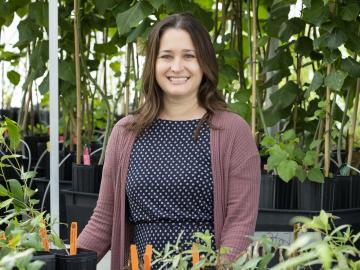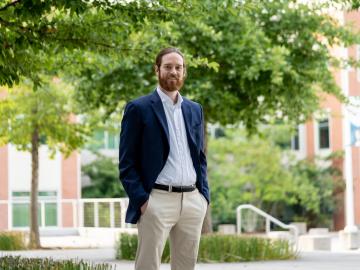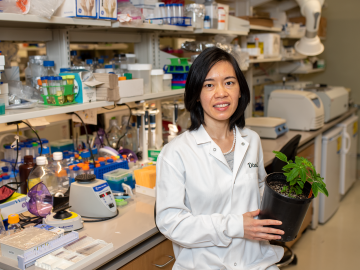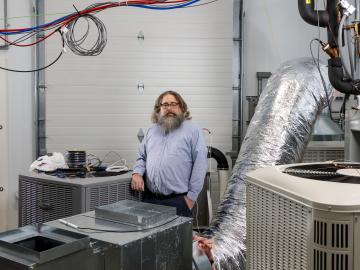
Filter News
Area of Research
- Advanced Manufacturing (2)
- Biological Systems (1)
- Biology and Environment (40)
- Computational Biology (1)
- Computer Science (1)
- Electricity and Smart Grid (1)
- Energy Science (59)
- Fusion and Fission (19)
- Fusion Energy (5)
- Isotopes (8)
- Materials (39)
- Materials for Computing (4)
- National Security (16)
- Neutron Science (21)
- Nuclear Science and Technology (17)
- Quantum information Science (1)
- Supercomputing (28)
News Type
News Topics
- (-) Bioenergy (70)
- (-) Biomedical (44)
- (-) Buildings (35)
- (-) Grid (34)
- (-) Machine Learning (40)
- (-) Materials (53)
- (-) Mathematics (9)
- (-) Nuclear Energy (71)
- (-) Space Exploration (13)
- (-) Transportation (35)
- 3-D Printing/Advanced Manufacturing (60)
- Advanced Reactors (13)
- Artificial Intelligence (79)
- Big Data (50)
- Biology (82)
- Biotechnology (26)
- Chemical Sciences (37)
- Clean Water (17)
- Composites (12)
- Computer Science (117)
- Coronavirus (20)
- Critical Materials (6)
- Cybersecurity (14)
- Education (2)
- Emergency (3)
- Energy Storage (37)
- Environment (124)
- Exascale Computing (51)
- Fossil Energy (6)
- Frontier (45)
- Fusion (40)
- High-Performance Computing (82)
- Hydropower (6)
- Isotopes (35)
- ITER (4)
- Materials Science (64)
- Mercury (7)
- Microelectronics (3)
- Microscopy (27)
- Molten Salt (2)
- Nanotechnology (21)
- National Security (63)
- Neutron Science (85)
- Partnerships (36)
- Physics (39)
- Polymers (12)
- Quantum Computing (35)
- Quantum Science (49)
- Security (18)
- Simulation (44)
- Software (1)
- Statistics (2)
- Summit (40)
Media Contacts

The Center for Bioenergy Innovation at ORNL offers a unique opportunity for early career scientists to conduct groundbreaking research while learning what it takes to manage a large collaborative science center.

A study by researchers at the ORNL takes a fresh look at what could become the first step toward a new generation of solar batteries.

Bryan Piatkowski, a Liane Russell Distinguished Fellow in the Biosciences Division at ORNL, is exploring the genetic pathways for traits such as stress tolerance in several plant species important for carbon sequestration

A team of researchers working within the Center for Bioenergy Innovation at ORNL has discovered a pathway to encourage a type of lignin formation in plants that could make the processing of crops grown for products such as sustainable jet fuels easier and less costly.

Every day, hundreds of thousands of commuters across the country travel from houses, apartments and other residential spaces to commercial buildings — from offices and schools to gyms and grocery stores.

To explore the inner workings of severe acute respiratory syndrome coronavirus 2, or SARS-CoV-2, researchers from ORNL developed a novel technique.

When Brian Fricke walks into a supermarket, evidence of his scientific achievement is all around in the refrigerated cases housing the fresh fruits and vegetables. As an Oak Ridge National Laboratory building equipment researcher, Fricke has a long history of making sure that produce is kept fresh in an energy efficient and environmentally sound manner.

A team of scientists led by the Department of Energy’s Oak Ridge National Laboratory and the Georgia Institute of Technology is using supercomputing and revolutionary deep learning tools to predict the structures and roles of thousands of proteins with unknown functions.

Neuromorphic devices — which emulate the decision-making processes of the human brain — show great promise for solving pressing scientific problems, but building physical systems to realize this potential presents researchers with a significant

Burak Ozpineci started out at ORNL working on a novel project: introducing silicon carbide into power electronics for more efficient electric vehicles. Twenty years later, the car he drives contains those same components.


